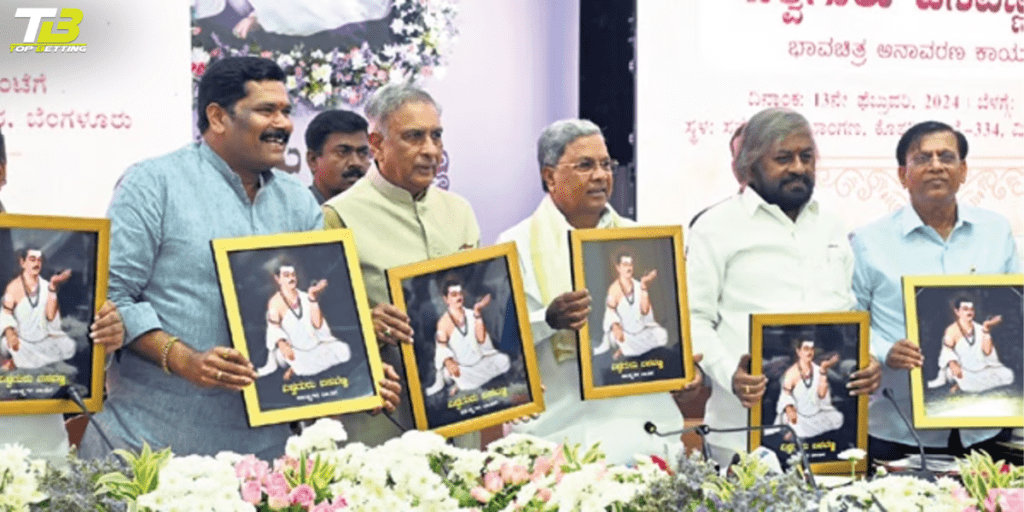
CM Siddaramaiah promotes
Siddaramaiah declared that Basavanna’s portrait will be unveiled in all government offices across the state on February 17.
After declaring Basavanna as the “cultural icon” of Karnataka, Chief Minister Siddaramaiah on Tuesday directed all government offices to affix his portrait with slogan ‘Vishwa Guru Basavanna, our cultural leader.’
Basavanna, a revered 12th-century philosopher, statesman, and poet, holds a significant place in Karnataka’s cultural and historical ethos. Karnataka Chief Minister Siddaramaiah has recently taken a noteworthy step by promoting the affixing of Basavanna’s portrait in all government offices across the state. This move is not just symbolic but holds deeper cultural and philosophical implications. Let’s explore the significance of this decision and its potential impact on the state’s administrative landscape.
Basavanna: A Cultural Icon
Basavanna, also known as Lord Basava or Basaveshwara, was a philosopher and statesman during the Kalachuri dynasty’s rule in the 12th century. He is best known for founding the Lingayat sect, which emphasizes devotion to Lord Shiva and rejects caste hierarchy. Basavanna’s vachanas (devotional poems) are revered for their spiritual and social messages, promoting equality, compassion, and inclusivity.
The Symbolism of Basavanna’s Portrait in Government Offices
Cultural Heritage: Affixing Basavanna’s portrait in government offices is a way to celebrate Karnataka’s rich cultural heritage. His teachings have transcended centuries and continue to inspire people, making him a revered figure in the state.
Promotion of Values: Basavanna’s vachanas emphasize values such as social justice, equality, and integrity. By displaying his portrait, the government aims to instill these values in the minds of employees and visitors, fostering a sense of responsibility and moral governance.
Inclusivity: The Lingayat sect, founded by Basavanna, promotes inclusivity and rejects caste-based discrimination. Displaying his portrait signifies the government’s commitment to fostering an inclusive and egalitarian work environment.
Educational Aspect: For those unfamiliar with Basavanna and his teachings, the portrait serves as an educational tool. It sparks curiosity and prompts individuals to learn about the cultural and historical context in which Basavanna lived.
Cultural Identity: Basavanna is an integral part of Karnataka’s cultural identity. Affixing his portrait in government offices reinforces the state’s commitment to preserving and celebrating its unique cultural tapestry.
Political Implications and Public Reception:
Political Symbolism: Siddaramaiah’s decision to promote Basavanna’s portrait in government offices carries political symbolism. It aligns with the Chief Minister’s outreach to the Lingayat community, a significant voter base in Karnataka. Recognizing Basavanna’s contributions resonates positively with a section of the electorate.
Cultural Harmony: While the decision has political implications, it also underscores the importance of cultural harmony and the need to celebrate Karnataka’s diverse cultural icons. Basavanna’s teachings cut across religious lines, promoting unity and understanding.
Public Support: The move has garnered support from various quarters, including cultural and literary circles, as well as religious leaders. Many view it as a positive step towards promoting cultural awareness and preserving the state’s unique heritage.
Challenges and Criticisms:
Religious Sensitivities: While Basavanna’s teachings emphasize inclusivity, the decision has faced criticisms from some quarters who perceive it as favoring one religious group. Balancing inclusivity without promoting religious favoritism remains a challenge.
Political Motivations: Critics argue that the move is driven by political considerations, especially in the run-up to elections. They question the sincerity of the government’s commitment to cultural preservation.
Implementation Challenges: Ensuring uniform implementation across all government offices may pose logistical challenges. The government needs to address issues related to standardization and guidelines for displaying Basavanna’s portrait.
He unveiled the portrait of the social reformer at a event organised at Vidhana Soudha Conference Hall in Bengaluru.
Siddaramaiah declared that Basavanna’s portrait will be unveiled in all government offices across the state on February 17, a decision is seen as Congress’s attempt to woo the Lingayat community in Karnataka ahead of the Lok Sabha polls.
“The district in-charge ministers at the district level, MLAs at the taluk level and the respective chairpersons in all the urban and rural organizations will do the honours. Basavanna’s portrait should be installed in all offices and his principles should be adopted at least a little in our lives,” the CM said.
Preaching Basavanna’s principles, he said, “Hatred is bad. We should be compassionate to others.”
Elaborating on his initiative to bring about change in society, Siddaramaiah said, “The old jail premises in Shimoga have been named Allama Prabhu. It was our government that named Bijapur Women’s University as Akka Mahahadevi University. We are doing these things to bring about change in society. The words of Basavadi Sharanas were relevant in the past and will remain significant in the future.”
“There is no shortage of funds in the government for Basavanna’s programmes,” he added.
Calling out the names of Buddha, Basavanna, Mahatma Gandhi, and Ambedkar, Siddaramaiah said that all of them aspired for a healthy and compassionate social system, adding to which he emphasised, “Casteism and superstitions are prevalent in society. Basavanna worked hard to eliminate inequality and made everyone live with self-respect.”
Conclusion:

Karnataka Chief Minister Siddaramaiah’s decision to promote the affixing of Basavanna’s portrait in government offices is a multi-faceted initiative with cultural, political, and social implications. It reflects a commitment to celebrating the state’s cultural heritage, promoting values of equality and social justice, and reaching out to specific voter demographics.










